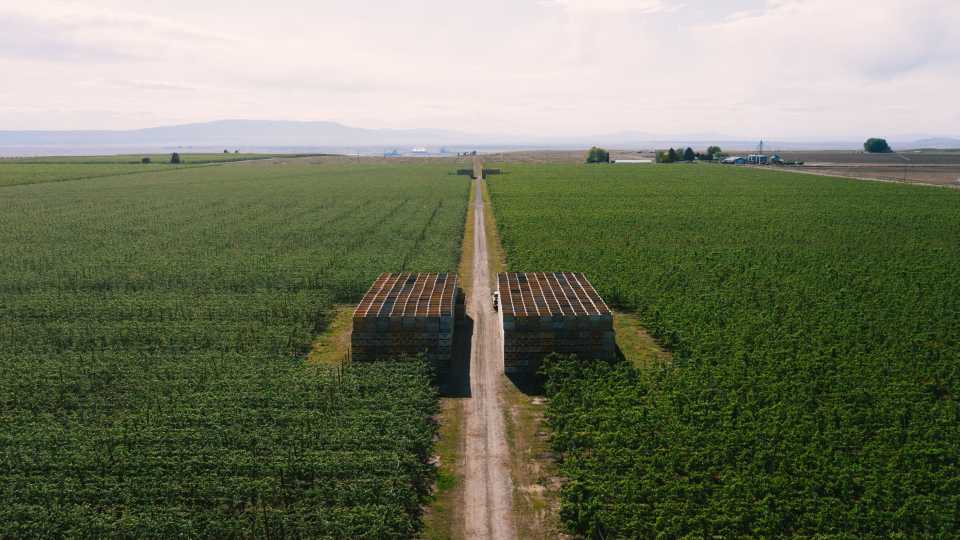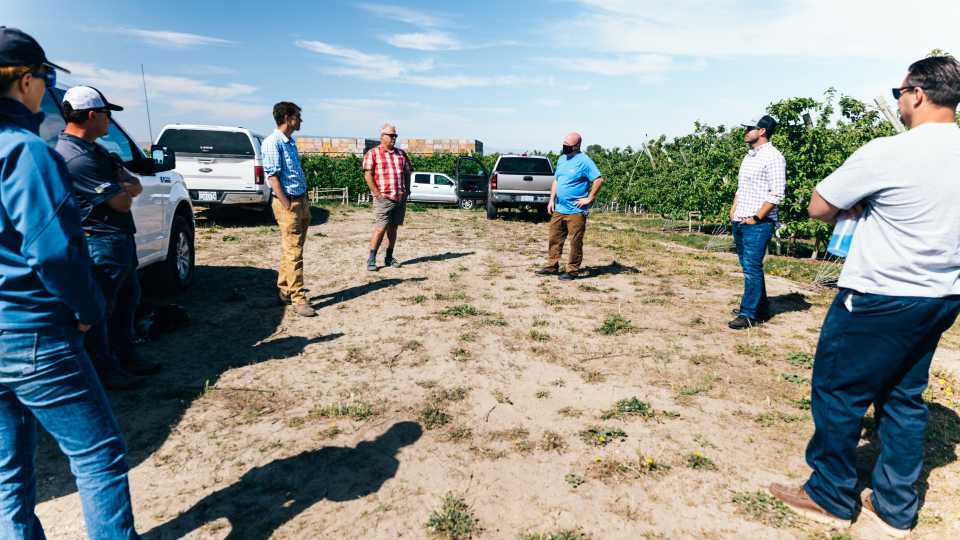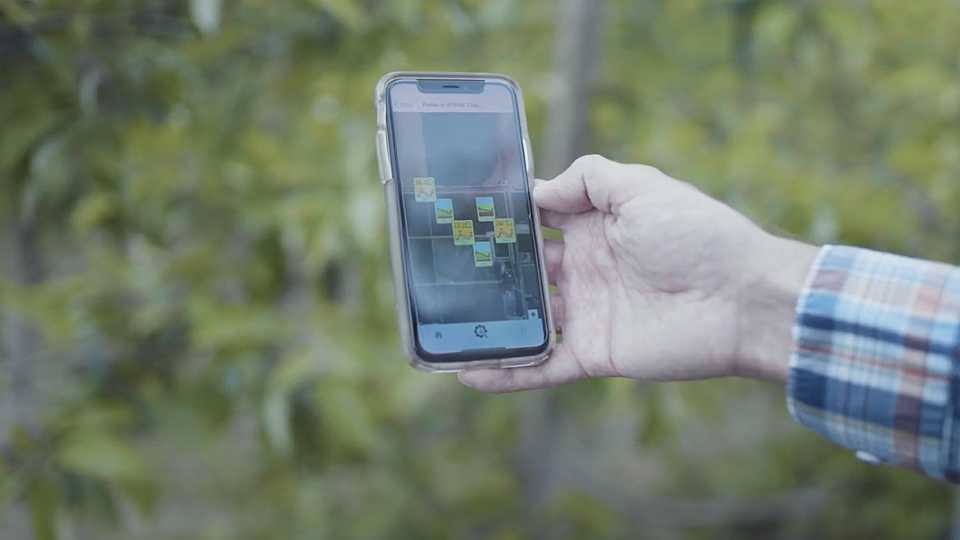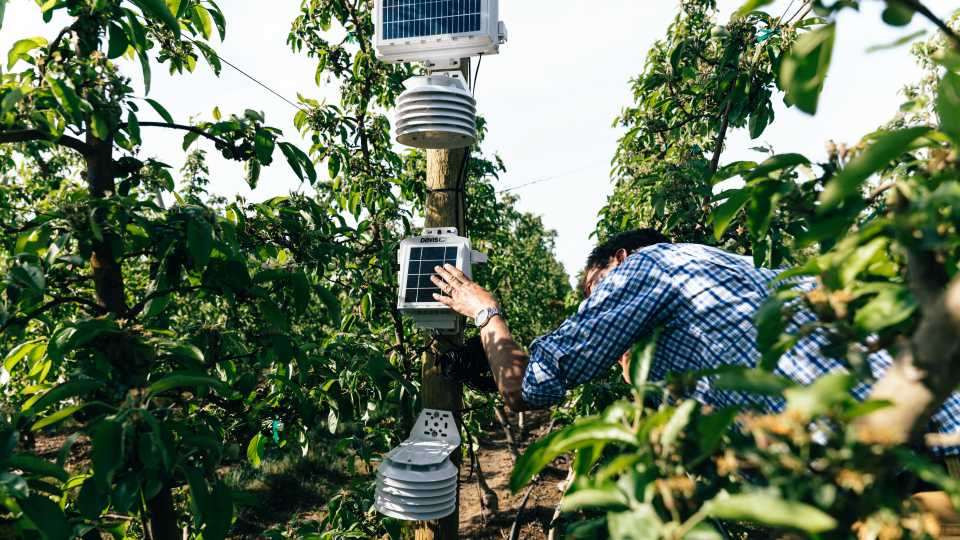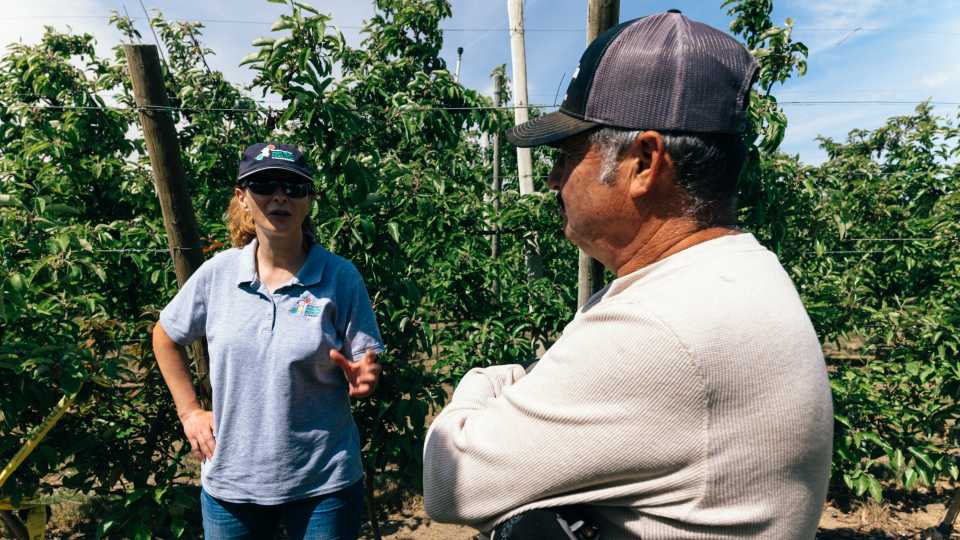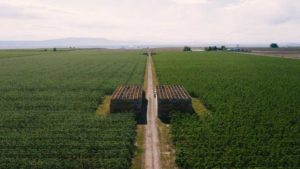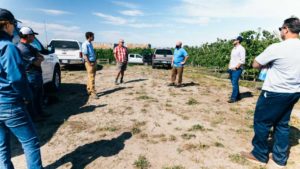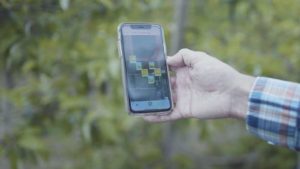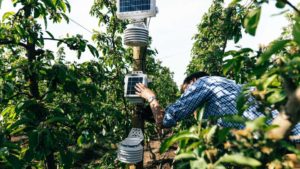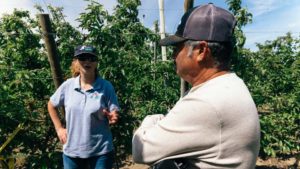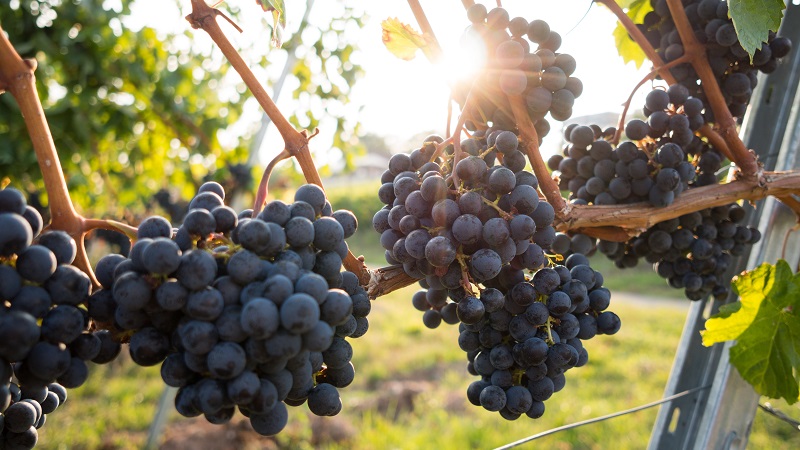Welcome To the Orchard of the Future Right Now
Smartphone etiquette is of no concern in the orchard of tomorrow (which is quickly becoming the orchard of today). When in doubt, whip one out … and say a little prayer for wireless connectivity.
More than ever the go-to tool in the field is an iPhone or an Android or, for those inclined, a laptop back at the home office. Surround it from every imaginable angle with a skyrocketing number of sensors that read everything but minds, and you have yourself a “smart orchard.”
The most noteworthy of these settings is Columbia Reach’s Chiawana Orchards in Pasco, WA. Since last March the apple farm, in partnership with the Washington Tree Fruit Research Commission (WTFRC), has entertained the Smart Orchard Project. Innov8.ag, a farm management venture from nearby Walla Walla, oversees the pilot program with support from Washington State and Oregon State universities.
The goal of the project, according to innov8.ag, is to “sensorize” orchards via multiple hardware providers, bringing together growers, data, and researchers to create a sustainable smart orchard with insights that impact grower profit.
Achieving data collaboration would erase the status quo. Steve Mantle, Founder and CEO of innov8.ag, knows of growers who have been simultaneously logging on to as many as 19 different apps. These “technology silos” — data types covering weather, equipment state, chemical records, soil nutrient updates, labor records, imagery, and yield predictions — are nearly endless.
“I don’t know how (growers) do it,” Mantle says.
IMMEDIATE RESULTS
At Chiawana Orchards the man in charge of doing it right is Field Operations Manager Shawn Tweedy. He has been dedicating a 20-acre bl››ock of his farm, comprising 99 rows of ‘Gala’ apple trees, to the project.
“Our organization here is pretty progressive in trying to grow the best fruit we can grow,” Tweedy says. “That was kind of the driver for this involvement.”
Tweedy exemplifies the data-drenched grower to which Mantle refers. He finds much of the available technology “very intriguing,” to the point where he “just wants to do it all.” But he knows he can’t, not without help. Few growers can.
“One of the things that we have struggled with in our organization — and that I think is a word of caution — is that vendors have to produce something for us, the growers, that is actionable immediately,” Tweedy says. “You can’t just give us a bunch of data to crunch. We just don’t have the capacity to do that. You’ve got to give us something that’s actionable on Monday when the data came in on Sunday.”
Irrigation is one example, Tweedy says. Growers can look at their moisture levels, but what can be done with that information? Ditto for smart sprayers, which, Tweedy says, do offer a lot of opportunity for savings. “But they have to work,” he stresses. “They have to be reliable; they have to be able to handle the environment. Those things make it very challenging.”
Tweedy says vendor information must be clean and, stealing a phrase from Mantle, he strives for the normalizing of data across the disciplines.
“Some data is handwritten. Some data is very crudely gathered. It’s not all pretty and importable immediately. It takes a little work to get it there,” Tweedy says.
Meanwhile, the bottom line is not the only concern. “It’s not always about cost savings. It’s also about what these technologies do to increase my yield; to grow better target fruit; to have fruit that’s more storable and less disease prone. All of these opportunities are out there,” Tweedy says. “But it’s not about a pretty picture on a graph. That’s not good enough. That’s this siloed kind of mentality and really a good illustration of where these technologies are and where they need to get to.”
And what is that destination? Tweedy and Mantle foresee the eventual removal of those silos in favor of an open-data format in which data is shared among all sources.
“That collaboration,” Tweedy says, “is just critical.”
ALL IN
Local researchers share Tweedy’s enthusiasm over the Smart Orchard Project. WTFRC Executive Director Ines Hanrahan praises the commitment of the entire Chiawana Orchards team.
“That was integral, to not just have what you would call the upper management buy in,” she says. “We had the entire team, all the way down to the ranch manager or to the irrigation lead, with us at all stages.”
Bernardita Sallato, a Tree Fruit Extension Specialist at Washington State University, jumped at the chance to participate in the pilot. Versed in soil and plant nutrition, she sees this as an opportunity to hone her expertise and outcomes.
“In general, the way Washington growers manage the nutrition in an orchard has been mainly by estimation in a very general way. We manage a block with an analysis, a methodology, that is still only an estimation,” she says. “This is different from, for example, a moisture sensor that we know has been validated and is highly correlated to the reality. With a soil test, we are a little behind that.”
Based on market demand, fruit quality, and ever-narrowing returns, Sallato says the industry needs to start learning how to manage nutrition at “something closer to a tree level.”
“This project really gives me the opportunity to learn, first, what are the technologies that are available today in the industry and then, to start validating those new technologies that might be really useful and applicable for managing nutrition in the orchards,” she says.
MAKING CONNECTIONS
For innov8.ag to achieve its goal of collaboration, data from the various sensor and probe providers must first be packaged together. Additional data is then added to the mix, starting with labor and including issues such as chemicals and water.
“We want to pull all of these different data sources, including drone imagery, into one place,” Mantle says. “But how do we make that real?”
Enter the smartphones. Leveraged with Microsoft’s ag data platform, Farmbeats, the innov8.ag app captures and visualizes real-time and historical data for growers. Artificial Intelligence (AI)-driven predictive offerings provide users with apple and bloom counts (base option), a dashboard with use cases (enhanced), and recommended insights for automation (premium).
It’s that simple … unless wireless connectivity is not at 100%, which is often the case in rural America. Chiawana Orchards typically checked in at 90% last season, according to Hanrahan.
“And that 90% is when we were standing outside the orchard,” Mantle clarifies. “It didn’t matter who your carrier was, (connectivity worsened) as soon as you stepped inside. And it gets worse as the season goes on because of the (increasing) density of the trees on the crop and the leaves and foliage.”
Tweedy encourages growers to make sure they have a good source for connectivity for all smart orchard projects.
“If you can’t get the data out, it doesn’t matter, you’ve just wasted your time,”
he says.
Innov8.ag is investigating newer connectivity technologies, including LoRa, a low-power wide-area network (WAN) modulation technique, and Citizens Broadband Radio Service (CBRS), a lightly licensed band that could enable enterprises to build their own private 4G/5G networks, resulting in improved 4G/5G offerings from service providers.
“What we’re exploring is how can we do (CBRS) affordably, where a grower or perhaps a group of growers could come together and have a shared dedicated LTE (long-term evolution), where it’s unlikely that a traditional phone company is going to build out,” Mantle says.
In the meantime, innov8.ag and WTFRC are now selecting the next site for an additional Smart Orchard Project. Interested growers should contact either organization.
Of note, project officials are seeking a block that has “a little bit more variability” than that found at Chiawana Orchards, according to Sallato. “We had pros and cons with Shawn because he had a very homogeneous orchard, at least on the nutrition side,” Sallato says. “It’s hard to evaluate the sensitivity of the technology when you have everything under control.”
Jokes Hanrahan: “I think, Shawn, this was not a criticism, it was a compliment.”
Companies Affiliated with INNOV8.AG’s Smart Orchard Project
- Davis Instruments (weather stations)
- Meter Group (nano-climate monitoring)
- Tuctronics (soil and weather sensors)
- Aqua Spy (soil moisture sensors)
- Sentek (soil moisture sensors)
- Teralytic (soil nutrient probes)
- Smart Guided Systems (sprayers)
- Phytech (plant stress sensing)





